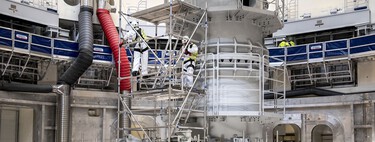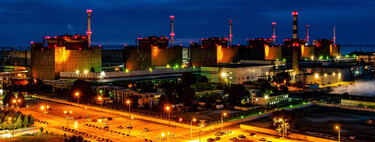Scientists are already stroking with their fingertips the solution to what is undoubtedly one of the biggest challenges proposed by nuclear fusion through magnetic confinement, which is the strategy ITER has opted for (International Thermonuclear Experimental Reactor).
As we have seen in other articles, the gas confined inside the reactor is extremely hot: nothing less than 150 million of degrees centigrade.
This figure is impressive on its own, but it is even more impressive if we bear in mind that the core of the Sun reaches a temperature of about 15 million degrees Celsius, and its surface is “only” 5500 degrees Celsius.
The gas confined inside the reactor reaches a temperature of no less than 150 million degrees Celsius
We need our nuclear fusion reactors to be able to heat the plasma, which is the extremely hot gas confined inside it, well above the temperature of the core of the Sun because the pressure with which we work is very inferior to that of the core of our star.
If we want the deuterium and tritium nuclei, which are the two isotopes of hydrogen that need to be introduced inside the reactor, to acquire the kinetic energy they need to overcome their natural electrical repulsion and begin to fuse, it is necessary for the plasma to reach a monstrous temperature.
Precisely those 150 million degrees Celsius that we have talked about. And, as we can guess, handling a gas at that temperature it’s not easy.
Plasma stabilization is one of the challenges that most worries scientists
The technology that needs to be fine-tuned so that in the 1960s (if we stick to the latest revision of the itinerary proposed by EUROfusion) they are ready the first power plants equipped with nuclear fusion reactors is very complex.
The challenges that need to be solved they are titanicbut little by little the researchers involved in this project are breaking down one barrier after another.
One of the biggest challenges requires finding new materials for the reactor mantle (known in English as blanket), a structure that covers the interior of the vacuum chamber and has a critical role: to protect the vacuum chamber itself, the cryostat and the magnets from the direct impact of high energy neutrons (14 MeV) that result from the fusion of deuterium and tritium nuclei.
The IFMIF-DONES project pursues, precisely, the development of new materials that are capable of withstanding neutron radiation with minimal degradation. But this is by no means the only challenge we have to solve if we want nuclear fusion to come to fruition.

The blanket (‘blanket’) is in the first line of battle because it is exposed to the direct impact of high-energy neutrons resulting from the fusion of deuterium and tritium nuclei.
Another very important challenge is to permanently keep under control plasma fluctuations to prevent it from coming into direct contact with the mantle of the vacuum chamber.
A group of researchers from MIT has been working for just over three years on the development of a new superconducting material known as YBCO (Yttrium-Barium-Copper Oxide) what combines yttrium oxide, barium and copper.
They propose using it in reactor magnets so that they are capable of generating a magnetic field that is significantly more intense than that produced by conventional magnets. This strategy should facilitate the stabilization of the plasma, and, in addition, could allow the construction of reactors 65 times more compact and noticeably more efficient.
EUROfusion’s strategy consists of introducing a third ingredient in the recipe
Before moving on, we want to take a small step back. When the plasma confined inside the reactor reaches the critical temperature and the deuterium and tritium nuclei begin to fuse thanks to the kinetic energy they have acquired, it arises as a result of this reaction a helium nucleus and the high-energy neutron that we talked about a few paragraphs above.
The neutrons have a neutral global electrical charge, and therefore they are ejected with great energy towards the walls of the container, where the mantle awaits them, which, as we have seen, is the first containment barrier. However, helium-4 nuclei, which they are ionized Since they lack electrons, and therefore have a positive electrical charge, they remain confined by the magnetic field inside the plasma.
These nuclei are also known as alpha particlesand when they begin to appear as a result of the first fusion reactions between deuterium and tritium nuclei, they become one more ingredient of the gas in which nuclear fusion is taking place.
Until very recently, scientists believed that when helium-4 nuclei began to give up their energy to the particle soup, their instability would increaseso these disturbances could represent a problem that would need to be solved.

This recreation of the building in which the ITER experimental nuclear reactor resides has been produced with the ANSYS software that facilitates the analysis of the structure using the finite element method.
The experimental nuclear fusion reactors available until now were not capable of sustaining the nuclear fusion reaction long enough to analyze the impact of the production of helium-4 nuclei. in plasma stability, but this scenario has recently changed. And it invites us to look to the future of this technology with optimism.
A group of European and American researchers has succeeded in using the ASDEX experimental tokamak reactor (Axially Symmetric Divertor Experiment) of the Max Planck Institute for Plasma Physics, located in Munich (Germany), to analyze the impact of helium-4 nuclei in the outermost layers of the plasma.
Helium-4 nuclei exert a stabilizing effect in the peripheral zone of the particle soup that makes up the plasma
Their work has been published in the scientific journal Physics of Plasmas, and shows that, contrary to initial belief, helium-4 nuclei have a stabilizing effect in the particle soup that makes up the plasma. In addition, the production of these nuclei contributes to further increasing the temperature of the gas, accelerating the generation of new helium-4 nuclei and increasing the net energy production.
There is no doubt that this is great news that, if finally consolidated, will represent a very important step forward in the effort to solve the challenge posed by plasma stabilization. There is still much left to do. Many challenges that must also be overcome. But it seems that with effort little by little we continue to advance towards a new way of obtaining energy that can lead us hand in hand with renewable energies towards a more hopeful future.
Images | ITER
More information | EUROfusion
George is Digismak’s reported cum editor with 13 years of experience in Journalism

